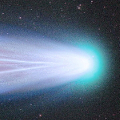
|
It brightened up to 3 mag in outburst on Dec. 14. Then several small outbursts occured repeatedly, and the comet has been fading gradually. But it is bright as 5.6 mag still now (Jan. 8, Chris Wyatt). In the Southern Hemisphere, it stays observable in the extremely low sky for a while. In the Northern Hemisphere, it is already unobservable. It will become observable again at 13 mag in late April.
Date(TT) R.A. (2000) Decl. Delta r Elong. m1 Best Time(A, h)
Jan. 8 21 42.09 -36 11.1 1.086 0.624 34 6.6 18:34 ( 45, -1)
Jan. 15 21 42.19 -36 24.7 1.312 0.666 29 7.3 18:40 ( 49, -6)
|
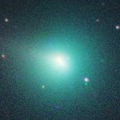
|
Now it is bright as 9.3 mag (Jan. 7, Michael Jager). It stays bright as 9-10 mag until March. In the Northern Hemisphere, it stays observable in excellent condition for a long time. In the Southern Hemisphere, it will be extremely low in February.
Date(TT) R.A. (2000) Decl. Delta r Elong. m1 Best Time(A, h)
Jan. 8 0 32.03 -13 12.2 1.196 1.340 75 9.1 18:34 ( 23, 39)
Jan. 15 0 46.84 -8 6.8 1.210 1.324 73 9.0 18:40 ( 31, 42)
|

|
Now it is very bright as 9.5 mag (Jan. 6, Carlos Labordena). It stays observable in good condition for a long time. It locates somewhat low in the Southern Hemisphere,
Date(TT) R.A. (2000) Decl. Delta r Elong. m1 Best Time(A, h)
Jan. 8 8 53.64 28 55.4 0.506 1.463 156 9.4 1:46 ( 0, 84)
Jan. 15 8 46.87 29 8.1 0.539 1.510 164 9.7 1:12 ( 0, 84)
|

|
Now it is 9.3 mag (Jan. 6, Marco Goiato). It stays bright as 10 mag until spring for a long time. It stays observable in good condition for a long time. It locates somewhat low in the Southern Hemisphere,
Date(TT) R.A. (2000) Decl. Delta r Elong. m1 Best Time(A, h)
Jan. 8 7 5.37 31 38.0 2.581 3.555 170 9.8 23:53 ( 0, 86)
Jan. 15 6 58.37 30 15.3 2.592 3.555 166 9.8 23:19 ( 0, 85)
|
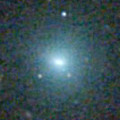
|
Brightened very rapidly. Now it is very bright as 9.9 mag (Jan. 8, Osamu Miyazaki). It is observable at 10 mag in good condition until February.
Date(TT) R.A. (2000) Decl. Delta r Elong. m1 Best Time(A, h)
Jan. 8 0 32.16 -3 22.0 0.665 1.074 78 10.0 18:34 ( 27, 48)
Jan. 15 1 1.80 -1 20.1 0.651 1.074 79 10.0 18:40 ( 30, 50)
|
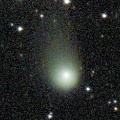
|
Now it is bright as 11.7 mag (Jan. 11, Osamu Miyazaki). It is expected to be observable at 5-6 mag for a long time from 2022 to 2023. In the Northern Hemisphere, it stays observable in good condition until autumn. However, it is not observable at the high light from autumn to 2023 summer. In the Southern Hemisphere, it will be observable after February. Then it will be observable in good condition at the high light.
Date(TT) R.A. (2000) Decl. Delta r Elong. m1 Best Time(A, h)
Jan. 8 18 3.27 12 48.4 5.049 4.333 39 10.9 5:38 (266, 16)
Jan. 15 18 8.91 12 24.0 4.962 4.270 41 10.8 5:38 (269, 21)
|

|
In the Northern Hemisphere, it stays extremely low until spring. In the Southern Hemisphere, it will appear in the morning sky at 11 mag in late January, then it stays observable at 11 mag until June.
Date(TT) R.A. (2000) Decl. Delta r Elong. m1 Best Time(A, h)
Jan. 8 17 12.48 -20 14.3 2.498 1.701 28 12.1 5:38 (300, 6)
Jan. 15 17 34.20 -20 39.9 2.444 1.674 30 11.9 5:38 (301, 7)
|
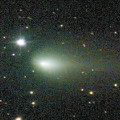
|
Now it is bright as 11.6 mag (Jan. 6, Carlos Labordena). It stays observable in good condition for a long time. But it will be fading gradually after this.
Date(TT) R.A. (2000) Decl. Delta r Elong. m1 Best Time(A, h)
Jan. 8 6 29.03 7 51.3 1.057 2.014 161 12.0 23:17 ( 0, 63)
Jan. 15 6 24.81 8 25.2 1.113 2.053 156 12.3 22:45 ( 0, 63)
|
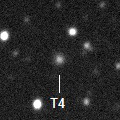
|
Now it is 13.3 mag (Jan. 3, Chris Wyatt). It will brighten up to 11.5 mag in spring. It stas observable in good condition for a long time.
Date(TT) R.A. (2000) Decl. Delta r Elong. m1 Best Time(A, h)
Jan. 8 12 3.72 -29 38.1 4.258 4.427 93 12.3 4:55 ( 0, 25)
Jan. 15 12 5.87 -29 42.2 4.143 4.411 99 12.2 4:29 ( 0, 25)
|
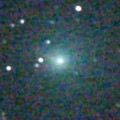
|
Now it is bright as 11.3 mag (Jan. 3, Chris Wyatt). It will be fading rapidly after this, and it will be fainter than 18 mag in March.
Date(TT) R.A. (2000) Decl. Delta r Elong. m1 Best Time(A, h)
Jan. 8 0 13.29 -17 29.8 1.928 1.832 69 12.6 18:34 ( 26, 33)
Jan. 15 0 29.56 -15 33.0 2.031 1.880 67 13.1 18:40 ( 32, 34)
|

|
Now it is 15.2 mag (Dec. 1, Ken-ichi Kadota). It will brighten up to 12 mag from winter to spring.
Date(TT) R.A. (2000) Decl. Delta r Elong. m1 Best Time(A, h)
Jan. 8 15 57.89 -15 51.8 2.145 1.638 46 12.8 5:38 (310, 22)
Jan. 15 16 18.78 -17 13.7 2.086 1.617 48 12.7 5:38 (312, 22)
|

|
Now it is 16.4 mag (Jan. 11, Jean-Francois Soulier).
Date(TT) R.A. (2000) Decl. Delta r Elong. m1 Best Time(A, h)
Jan. 8 4 19.39 30 45.4 5.159 5.946 140 13.4 21:08 ( 0, 86)
Jan. 15 4 17.50 30 29.9 5.238 5.949 132 13.4 20:39 ( 0, 86)
|
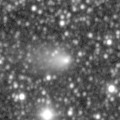
|
It brightened up to 11.5 mag in outburst in October (Oct. 22, Marco Goiato). Now it is fading. It has already faded down to 14.1 mag (Jan. 1, J.-G. Bosch, F. Kugel, J. Nicolas). In the Southern Hemisphere, it is already unobservable. In the Northern Hemisphere, it stays observable until early February.
Date(TT) R.A. (2000) Decl. Delta r Elong. m1 Best Time(A, h)
Jan. 8 21 53.46 -11 55.8 2.537 1.878 39 14.0 18:34 ( 61, 18)
Jan. 15 22 10.82 -10 28.8 2.604 1.904 36 14.3 18:40 ( 64, 16)
|

|
It brightened up to 12.3 mag from spring to summer (June 15, Marco Goiato). Now it is fading. It has already faded down to 14.9 mag (Jan. 1, Toshihiko Ikemura, Hirohisa Sato).
Date(TT) R.A. (2000) Decl. Delta r Elong. m1 Best Time(A, h)
Jan. 8 14 28.82 5 27.7 4.285 4.145 75 14.0 5:38 (316, 52)
Jan. 15 14 28.30 6 44.9 4.193 4.182 82 14.0 5:38 (325, 57)
|

|
It brightened up to 9.5 mag in early summer (June 27, Marco Goiato). Now it is fading. It has faded down to 12.7 mag in autumn (Nov. 22, Thomas Lehmann). Now it is not observable. In the Southern Hemisphere, it will appear in the morning sky at 15 mag in late February. In the Northern Hemisphere, it is not observable until June when the comet will fade down to 17 mag.
Date(TT) R.A. (2000) Decl. Delta r Elong. m1 Best Time(A, h)
Jan. 8 19 54.01 -33 16.8 3.873 2.928 13 14.1 18:34 ( 61,-17)
Jan. 15 20 8.19 -33 10.1 3.933 2.982 12 14.3 18:40 ( 63,-20)
|

|
Now it is 15.1 mag (Dec. 14, Chris Wyatt). It will brighten up to 13 mag in spring. In the Southern Hemisphere, it stays observable in good condition for a long time. In the Northern Hemisphere, it is not observable until autumn.
Date(TT) R.A. (2000) Decl. Delta r Elong. m1 Best Time(A, h)
Jan. 8 12 41.14 -55 29.0 3.590 3.493 76 14.2 5:32 ( 0, -1)
Jan. 15 12 33.81 -58 9.6 3.478 3.464 81 14.1 4:58 ( 0, -3)
|

|
It brightened very rapidly, and brightened up to 8.9 mag (Sept. 11, Chris Wyatt). Now it is fading. It has already faded down to 15.7 mag (Dec. 7, E. Cortes, N. Paul, B. Lutkenhoner). In the Southern Hemisphere, it stays observable after this while the comet will be fading. It is not observable after this in the Northern Hemisphere.
Date(TT) R.A. (2000) Decl. Delta r Elong. m1 Best Time(A, h)
Jan. 8 16 16.38 -53 42.1 2.659 2.099 45 14.4 5:38 (332,-10)
Jan. 15 16 33.77 -54 2.9 2.689 2.170 48 14.8 5:38 (333, -9)
|

|
Now it is 15.2 mag (Jan. 1, Toshihiko Ikemura, Hirohisa Sato). It will brighten rapidly, and it will be observable at 13.5 mag in good condition from winter to spring.
Date(TT) R.A. (2000) Decl. Delta r Elong. m1 Best Time(A, h)
Jan. 8 10 9.05 16 39.9 1.725 2.548 138 14.8 3:01 ( 0, 72)
Jan. 15 10 7.60 16 54.8 1.649 2.526 146 14.6 2:32 ( 0, 72)
|
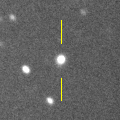
|
Now it is 13.8 mag (Jan. 7, Toshihiko Ikemura, Hirohisa Sato). It is expected to brighten up to 10 mag in 2023. In the Northern Hemisphere, it stays observable in good condition until 2023 autumn. In the Southern Hemipshere, it locates extremely low from January to February. Then it stays unobservable until 2023 summer.
Date(TT) R.A. (2000) Decl. Delta r Elong. m1 Best Time(A, h)
Jan. 8 13 6.82 42 48.8 5.078 5.439 106 14.9 5:38 (205, 81)
Jan. 15 13 6.03 44 23.3 4.942 5.382 111 14.8 5:29 (180, 81)
|
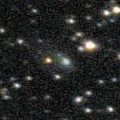
|
Now it is 14.9 mag (Nov. 28, Thomas Lehmann). It is expected to brighten up to 11 mag from spring to summer. In the Southen Hemisphere, it is not observable until February, but it stays observable in good condition for a long time after that. In the Northern Hemisphere, it is hardly observable after this.
Date(TT) R.A. (2000) Decl. Delta r Elong. m1 Best Time(A, h)
Jan. 8 19 22.61 -8 25.5 3.561 2.617 13 14.9 18:34 ( 86, -9)
Jan. 15 19 29.08 -9 35.1 3.510 2.558 12 14.8 5:38 (276, -8)
|

|
Now it is 15.7 mag (Dec. 28, D. Buczynski). It is expected to brighten up to 11 mag in 2023. In the Northern Hemisphere, it stays observable in good condition for a long time. It is not observable in the Southern Hemisphere.
Date(TT) R.A. (2000) Decl. Delta r Elong. m1 Best Time(A, h)
Jan. 8 16 38.07 31 13.6 5.639 5.307 65 15.0 5:38 (257, 42)
Jan. 15 16 39.98 31 33.2 5.537 5.265 69 14.9 5:38 (260, 47)
|

|
Now it is 15.8 mag (Oct. 4, Thomas Lehmann). Appearing in the morning. It will brighten up to 13 mag in summer.
Date(TT) R.A. (2000) Decl. Delta r Elong. m1 Best Time(A, h)
Jan. 8 16 53.27 -23 19.2 3.950 3.167 32 15.0 5:38 (306, 8)
Jan. 15 17 4.27 -23 45.8 3.884 3.158 37 14.9 5:38 (309, 10)
|

|
Now it is 15.9 mag (Jan. 2, Thomas Lehmann). It will brighten up to 12.5 mag in summer. In the Southern Hemisphere, it stays observable in excellent condition for a long time. In the Northern Hemisphere, it is not observable until August.
Date(TT) R.A. (2000) Decl. Delta r Elong. m1 Best Time(A, h)
Jan. 8 22 18.55 -63 29.3 4.380 3.840 51 15.1 18:34 ( 22,-16)
Jan. 15 22 19.06 -62 7.3 4.377 3.799 48 15.0 18:40 ( 25,-18)
|

|
It brightened rapidly. Now it is 14.8 mag (Jan. 7, Toshihiko Ikemura, Hirohisa Sato). It is observable at 15 mag in excellent condition in winter.
Date(TT) R.A. (2000) Decl. Delta r Elong. m1 Best Time(A, h)
Jan. 8 8 27.54 15 23.7 1.554 2.507 161 15.1 1:20 ( 0, 70)
Jan. 15 8 21.61 15 2.5 1.542 2.516 169 15.2 0:46 ( 0, 70)
|

|
It brightened up to 13.1 mag in autumn (Oct. 28, Toshihiko Ikemura, Hirohisa Sato). Now it is fading. But it is bright as 14.2 mag still now (Jan. 1, Toshihiko Ikemura, Hirohisa Sato). It stays observable in good condition for a long time. But it will be fainter than 18 mag in March.
Date(TT) R.A. (2000) Decl. Delta r Elong. m1 Best Time(A, h)
Jan. 8 1 51.31 4 20.1 1.322 1.779 99 15.1 18:41 ( 0, 60)
Jan. 15 2 4.67 5 43.6 1.402 1.801 96 15.4 18:40 ( 7, 61)
|
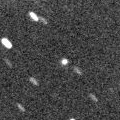
|
Now it is 15.6 mag (Dec. 28, D. Buczynski). It is expected to brighten very rapidly up to 4.5 mag in April. However, it is not observable at the high light. In the Northern Hemisphere, it stays observable until early February when it brightens up to 14 mag. Then it will appear at 6 mag in mid May, and it stays observable in good condition after that while the comet will be fading. In the Southern Hemisphere, it is not observable until August.
Date(TT) R.A. (2000) Decl. Delta r Elong. m1 Best Time(A, h)
Jan. 8 22 21.42 2 26.3 2.636 2.168 51 15.5 18:34 ( 67, 33)
Jan. 15 22 28.99 1 49.8 2.616 2.059 46 15.2 18:40 ( 71, 28)
|

|
Now it is 15.9 mag (Oct. 8, Thomas Lehmann). It stays at 14-15 mag for a long time from 2021 to 2022. It is not observable from November to January.
Date(TT) R.A. (2000) Decl. Delta r Elong. m1 Best Time(A, h)
Jan. 8 17 6.12 -29 56.9 5.847 5.019 29 15.3 5:38 (308, 1)
Jan. 15 17 9.43 -30 48.7 5.785 5.024 36 15.3 5:38 (313, 4)
|
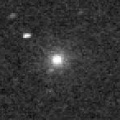
|
It was observed at 9-10 mag from late July to early August. Although it had been unobservable for a long time, it is appearing in the morning sky now.
Date(TT) R.A. (2000) Decl. Delta r Elong. m1 Best Time(A, h)
Jan. 8 16 2.39 -23 6.5 3.120 2.512 44 15.5 5:38 (314, 16)
Jan. 15 16 10.55 -24 3.6 3.131 2.601 49 15.6 5:38 (318, 18)
|
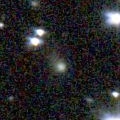
|
Now it is 16.0 mag (Dec. 8, A. Diepvens). It is expected to brighten up to 11 mag in 2023. In the Northern Hemisphere, it stays observable in good condition until November. But it becomes unobservable after that. In the Southern Hemisphere, it is not observable until February. But it will be observable in good condition at the high light.
Date(TT) R.A. (2000) Decl. Delta r Elong. m1 Best Time(A, h)
Jan. 8 18 21.52 18 17.0 6.106 5.424 42 15.7 5:38 (258, 16)
Jan. 15 18 26.33 17 57.0 6.043 5.376 43 15.7 5:38 (262, 20)
|
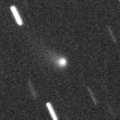
|
Now it is 15.5 mag (Jan. 1, Toshihiko Ikemura, Hirohisa Sato). It stays observable at 15-16 mag for a long time.
Date(TT) R.A. (2000) Decl. Delta r Elong. m1 Best Time(A, h)
Jan. 8 13 12.87 13 44.2 3.064 3.310 95 15.7 5:38 (343, 68)
Jan. 15 13 8.30 13 13.4 2.972 3.339 103 15.7 5:32 ( 0, 68)
|
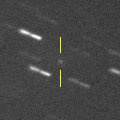
|
Now it is bright as 15.4 mag (Jan. 8, Ken-ichi Kadota. Cometary activity was detected. In the Northern Hemisphere, it is observable only until early March. In the Southern Hemisphere, it is not observable until late May. But it will be observable in good condition after that.
Date(TT) R.A. (2000) Decl. Delta r Elong. m1 Best Time(A, h)
Jan. 8 16 26.84 36 10.9 1.802 1.745 70 16.1 5:38 (252, 46)
Jan. 15 16 58.62 39 29.3 1.674 1.662 72 15.8 5:38 (247, 46)
|
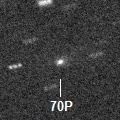
|
Now it is 16.2 mag (Dec. 29, Ken-ichi Kadota). It will brighten up to 15.5 mag, and will be observable in excellent condition in winter.
Date(TT) R.A. (2000) Decl. Delta r Elong. m1 Best Time(A, h)
Jan. 8 11 43.09 6 41.1 1.477 2.079 113 15.9 4:34 ( 0, 62)
Jan. 15 11 48.11 6 47.9 1.423 2.094 119 15.8 4:12 ( 0, 62)
|
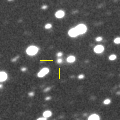
|
First return of a new periodic comet observed at 16 mag from 2003 to 2004. Now it is 16.1 mag (Jan. 3, Toshihiko Ikemura, Hirohisa Sato). It stays 16 mag until March, and it stays observable in excellent condition.
Date(TT) R.A. (2000) Decl. Delta r Elong. m1 Best Time(A, h)
Jan. 8 6 13.61 4 6.6 3.019 3.940 156 15.8 23:02 ( 0, 59)
Jan. 15 6 9.78 4 57.8 3.049 3.942 151 15.9 22:30 ( 0, 60)
|

|
Now it is 15.6 mag (Dec. 27, Ken-ichi Kadota). It will be fading after this. It will be unobservable soon in the Southern Hemisphere, or in early February in the Northern Hemisphere.
Date(TT) R.A. (2000) Decl. Delta r Elong. m1 Best Time(A, h)
Jan. 8 22 43.13 -14 5.1 5.511 4.934 49 15.9 18:34 ( 50, 25)
Jan. 15 22 47.32 -12 58.0 5.621 4.961 44 16.0 18:40 ( 56, 21)
|

|
Now it is 15.4 mag (Dec. 29, Ken-ichi Kadota). It will be fading after this. In the Northern Hemisphere, it stays observable in good condition for a long time. In the Southern Hemisphere, it is not observable until late January.
Date(TT) R.A. (2000) Decl. Delta r Elong. m1 Best Time(A, h)
Jan. 8 16 12.78 21 3.4 2.869 2.561 62 16.0 5:38 (273, 43)
Jan. 15 16 11.15 22 27.1 2.796 2.595 68 16.0 5:38 (276, 50)
|

|
Now it is 16.5 mag (Dec. 19, E. Cortes, B. Lutkenhoner). It will be fading slowly after this. In the Southern Hemisphere, it stays observable in good condition for a long time. In the Northern Hemisphere, it is not observable until July.
Date(TT) R.A. (2000) Decl. Delta r Elong. m1 Best Time(A, h)
Jan. 8 23 19.65 -52 26.2 4.500 4.017 54 16.0 18:34 ( 21, -3)
Jan. 15 23 29.03 -50 30.4 4.572 4.045 52 16.1 18:40 ( 25, -3)
|
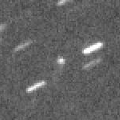
|
Now it is 16.6 mag (Dec. 10, ATLAS-MLO, Mauna Loa). In the Northern Hemisphere, it stays observable at 16 mag in good condition for a long time. In the Southern Hemisphere, it is not observable until 2023.
Date(TT) R.A. (2000) Decl. Delta r Elong. m1 Best Time(A, h)
Jan. 8 18 53.91 89 12.9 3.410 3.880 111 16.1 5:38 (181, 35)
Jan. 15 22 1.06 87 3.5 3.434 3.865 108 16.1 18:40 (177, 36)
|

|
Brightened rapidly. Now it is 16.0 mag (Jan. 1, Toshihiko Ikemura, Hirohisa Sato). It is observable at 15.5-16 mag in good condition until winter.
Date(TT) R.A. (2000) Decl. Delta r Elong. m1 Best Time(A, h)
Jan. 8 2 7.21 11 11.9 3.419 3.811 106 16.1 18:56 ( 0, 66)
Jan. 15 2 10.26 11 13.6 3.524 3.815 99 16.2 18:40 ( 5, 66)
|
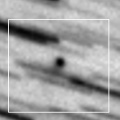
|
Now it is 16.0 mag (Dec. 28, D. Buczynski). It is expected to brighten up to 11 mag in summer. In the Northern Hemisphere, it stays observable in good condition until June when it brightens up to 11 mag. But it is not observable after the high light. In the Souther Hemisphere, it is not observable until October.
Date(TT) R.A. (2000) Decl. Delta r Elong. m1 Best Time(A, h)
Jan. 8 22 43.78 51 52.9 2.968 3.078 87 16.2 18:34 (132, 54)
Jan. 15 22 50.41 51 22.9 2.955 3.000 83 16.1 18:40 (131, 50)
|
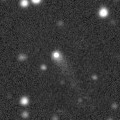
|
Now it is 16.3 mag (Jan. 7, Toshihiko Ikemura, Hirohisa Sato). It stays observable at 16 mag from 2021 to 2022. Appearing in the morning sky also in the Southern Hemisphere.
Date(TT) R.A. (2000) Decl. Delta r Elong. m1 Best Time(A, h)
Jan. 8 15 48.91 11 3.0 5.173 4.768 60 16.2 5:38 (289, 42)
Jan. 15 15 54.20 12 11.3 5.094 4.777 65 16.2 5:38 (292, 47)
|

|
It has not been observed yet in this return. It will brighten up to 16.5 mag in January. It locates low in the evening.
Date(TT) R.A. (2000) Decl. Delta r Elong. m1 Best Time(A, h)
Jan. 8 22 30.24 -15 0.8 1.590 1.160 46 16.6 18:34 ( 51, 22)
Jan. 15 22 55.18 -10 57.1 1.596 1.163 46 16.6 18:40 ( 56, 24)
|

|
Now it is 17.7 mag (Jan. 2, J. Drummond). It brightened rapidly. It stays 17 mag for a long time from 2021 to 2022. In the Southern Hemisphere, it stays observable in good condition for a long time. In the Northern Hemisphere, it will be observable only in extremely low sky from autumn to winter.
Date(TT) R.A. (2000) Decl. Delta r Elong. m1 Best Time(A, h)
Jan. 8 8 19.50 -45 3.9 4.915 5.348 111 16.7 1:11 ( 0, 10)
Jan. 15 8 9.51 -45 55.6 4.896 5.352 112 16.7 0:34 ( 0, 9)
|
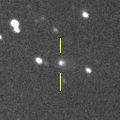
|
Now it is 16.7 mag (Jan. 7, Toshihiko Ikemura, Hirohisa Sato). It continued brightening for a while even after the perihelion passage. It stays observable at 16-17 mag in good condition for a while.
Date(TT) R.A. (2000) Decl. Delta r Elong. m1 Best Time(A, h)
Jan. 8 4 25.74 -12 50.6 3.278 3.932 125 16.8 21:14 ( 0, 42)
Jan. 15 4 23.68 -11 48.3 3.361 3.951 120 16.8 20:44 ( 0, 43)
|
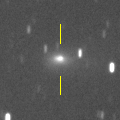
|
It brightened even after the perihelion passage, and it brightened up to 13.5 mag in December (Dec. 6, Katsumi Yoshimoto). Now it is fading. It has already faded down to 16.8 mag (Jan. 8, Toshihiko Ikemura, Hirohisa Sato). It is observable in excellent condition in the Northern Hemisphere. It locates low in the Southern Hemisphere.
Date(TT) R.A. (2000) Decl. Delta r Elong. m1 Best Time(A, h)
Jan. 8 6 55.88 40 43.2 1.066 2.022 161 16.8 23:44 (180, 84)
Jan. 15 6 49.44 40 53.7 1.117 2.058 156 17.1 23:10 (180, 84)
|

|
Now it is 16.9 mag (Jan. 8, Toshihiko Ikemura, Hirohisa Sato). Fading slowly. In the Northern Hemisphere, it stays observable in good condition for a long time. In the Southern Hemisphere, it is not observable after this.
Date(TT) R.A. (2000) Decl. Delta r Elong. m1 Best Time(A, h)
Jan. 8 18 52.61 48 7.1 9.274 8.996 70 16.8 5:38 (227, 25)
Jan. 15 18 56.42 48 34.6 9.281 9.004 70 16.8 5:38 (228, 28)
|
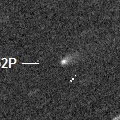
|
Now it is 16.7 mag (Dec. 29, Ken-ichi Kadota). It stays observable at 17 mag from autumn to winter.
Date(TT) R.A. (2000) Decl. Delta r Elong. m1 Best Time(A, h)
Jan. 8 12 39.70 -5 26.7 1.622 1.984 96 16.8 5:31 ( 0, 49)
Jan. 15 12 45.74 -6 50.2 1.574 2.013 101 16.8 5:09 ( 0, 48)
|

|
First return of a new periodic comet which brightened up to 17 mag in 2011. Now it is 17.2 mag (Dec. 13, Catalina Sky Survey). It stays observable at 17 mag in good condition until spring.
Date(TT) R.A. (2000) Decl. Delta r Elong. m1 Best Time(A, h)
Jan. 8 13 53.99 -7 3.8 1.469 1.595 78 16.9 5:38 (336, 45)
Jan. 15 14 9.39 -8 28.6 1.431 1.611 81 16.9 5:38 (341, 45)
|
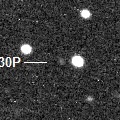
|
Now it is 18.7 mag (Jan. 1, W. Hasubick). It was expected to brighten up to 16.5-17 mag in winter. In its last apparition in 2015, it brightened up to 13 mag. But actually, it is fainter than this ephemeris recently.
Date(TT) R.A. (2000) Decl. Delta r Elong. m1 Best Time(A, h)
Jan. 8 23 38.27 -17 9.2 1.953 1.719 61 17.0 18:34 ( 35, 30)
Jan. 15 23 53.43 -15 2.5 1.977 1.692 58 17.0 18:40 ( 41, 30)
|
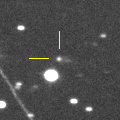
|
Now it is 16.7 mag (Jan. 8, Toshihiko Ikemura, Hirohisa Sato). It will brighten up to 14 mag in early 2023. It stays observable in good condition until spring.
Date(TT) R.A. (2000) Decl. Delta r Elong. m1 Best Time(A, h)
Jan. 8 4 21.87 3 36.8 4.183 4.918 134 17.0 21:10 ( 0, 59)
Jan. 15 4 19.98 4 3.3 4.216 4.875 127 17.0 20:41 ( 0, 59)
|
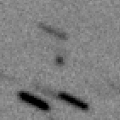
|
Now it is 17.4 mag (Dec. 23, ATLAS-HKO, Haleakala). It is observable at 17 mag from November to March. It is observable in good condition in the Northern Hemisphere, but it locates low in the Southern Hemisphere.
Date(TT) R.A. (2000) Decl. Delta r Elong. m1 Best Time(A, h)
Jan. 8 5 28.17 28 3.2 1.613 2.539 155 17.1 22:16 ( 0, 83)
Jan. 15 5 23.89 28 43.0 1.643 2.526 147 17.1 21:45 ( 0, 84)
|

|
Now it is 16.4 mag (Oct. 4, ATLAS-MLO, Mauna Loa). In the Southern Hemisphere, it stays observable for a long time. In the Northern Hemisphere, it is not observable after this.
Date(TT) R.A. (2000) Decl. Delta r Elong. m1 Best Time(A, h)
Jan. 8 11 43.69 -54 51.4 3.723 3.751 84 17.2 4:35 ( 0, 0)
Jan. 15 11 35.54 -54 54.1 3.677 3.799 89 17.2 3:59 ( 0, 0)
|

|
Now it is 16.8 mag (Jan. 6, Michael Jager). Now it is approaching to Earth down to 0.3 a.u. and it brightened up to 17 mag. But it will fade out quickly.
Date(TT) R.A. (2000) Decl. Delta r Elong. m1 Best Time(A, h)
Jan. 8 6 54.21 27 20.6 0.321 1.302 173 17.2 23:29 ( 0, 81)
Jan. 15 4 46.57 5 57.0 0.380 1.277 134 17.5 21:01 ( 0, 60)
|
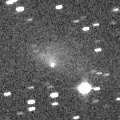
|
It brightened up to 10.1 mag in spring (Apr. 10, Marco Goiato). Now it is fading. It has already faded down to 16.5 mag (Dec. 30, Ken-ichi Kadota). It stays observable in good condition for a long time after this while the comet will fading.
Date(TT) R.A. (2000) Decl. Delta r Elong. m1 Best Time(A, h)
Jan. 8 3 44.36 7 49.7 2.185 2.889 127 17.2 20:33 ( 0, 63)
Jan. 15 3 43.66 8 29.3 2.303 2.928 120 17.4 20:05 ( 0, 64)
|

|
Now it is 16.6 mag (Dec. 25, D. Buczynski). Fading slowly. It is not observable until April in the Southern Hemisphere.
Date(TT) R.A. (2000) Decl. Delta r Elong. m1 Best Time(A, h)
Jan. 8 21 43.29 17 52.0 6.861 6.334 54 17.2 18:34 ( 89, 34)
Jan. 15 21 46.22 17 18.4 6.959 6.351 48 17.3 18:40 ( 93, 28)
|
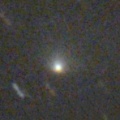
|
It brightened up to 14.5 mag in autumn (Oct. 1, Ken-ichi Kadota). Now it is fading. It has already faded down to 16.4 mag (Jan. 1, Toshihiko Ikemura, Hirohisa Sato). It will be fading rapidly after this. It will be fainter than 18 mag in February.
Date(TT) R.A. (2000) Decl. Delta r Elong. m1 Best Time(A, h)
Jan. 8 0 17.68 -8 50.9 2.524 2.433 73 17.2 18:34 ( 29, 42)
Jan. 15 0 27.86 -7 37.7 2.619 2.449 69 17.4 18:40 ( 37, 40)
|

|
It brightened up to 15.2 mag in autumn (Oct. 11, Purple Mountain Observatory, XuYi Station). Now it is fading very rapidly. It has already faded down to 19.0 mag (Jan. 3, Toshihiko Ikemura, Hirohisa Sato).
Date(TT) R.A. (2000) Decl. Delta r Elong. m1 Best Time(A, h)
Jan. 8 0 4.85 9 59.6 2.380 2.377 77 17.3 18:34 ( 48, 56)
Jan. 15 0 15.28 11 2.5 2.481 2.397 73 17.4 18:40 ( 57, 53)
|

|
Now it is 17.2 mag (Jan. 7, Toshihiko Ikemura, Hirohisa Sato). It stays observable at 17-18 mag for a long time until 2024.
Date(TT) R.A. (2000) Decl. Delta r Elong. m1 Best Time(A, h)
Jan. 8 14 39.19 -5 15.7 9.196 8.885 68 17.3 5:38 (321, 42)
Jan. 15 14 39.06 -5 1.8 9.071 8.880 75 17.3 5:38 (329, 45)
|
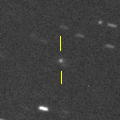
|
Now it is 17.4 mag (Jan. 7, Toshihiko Ikemura, Hirohisa Sato). It will brighten up to 11.5 mag in 2022 winter. It stays observable while the comet will be brightening slowly.
Date(TT) R.A. (2000) Decl. Delta r Elong. m1 Best Time(A, h)
Jan. 8 2 57.82 12 54.7 2.643 3.228 118 17.3 19:47 ( 0, 68)
Jan. 15 2 57.19 13 1.1 2.702 3.191 111 17.3 19:18 ( 0, 68)
|

|
Now it is 17.8 mag (Jan. 8, Toshihiko Ikemura, Hirohisa Sato). It stays 17-18 mag for a long time from 2021 to 2022. It is observable in excellent condition in the Northern Hemisphere, It locates somewhat low in the Southern Hemisphere.
Date(TT) R.A. (2000) Decl. Delta r Elong. m1 Best Time(A, h)
Jan. 8 3 5.42 30 31.3 4.782 5.395 124 17.3 19:54 ( 0, 86)
Jan. 15 2 58.56 29 52.4 4.890 5.389 115 17.3 19:20 ( 0, 85)
|
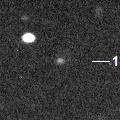
|
Now it is 16.8 mag (Jan. 1, Toshihiko Ikemura, Hirohisa Sato). It will brighten up to 15 mag in 2022 winter. It will be unobservable in February.
Date(TT) R.A. (2000) Decl. Delta r Elong. m1 Best Time(A, h)
Jan. 8 23 17.57 -11 29.5 3.126 2.745 58 17.4 18:34 ( 44, 32)
Jan. 15 23 26.66 -10 23.3 3.181 2.722 53 17.3 18:40 ( 50, 29)
|

|
Now it is 17.6 mag (Dec. 11, Toshihiko Ikemura, Hirohisa Sato). It was expected to brighten up to 15.5 mag in winter. But actually, it is fading even before the perihelion passage. In the Northern Hemisphere, it stays observable in good condition for a long time. It is not observable at all in the Southern Hemisphere.
Date(TT) R.A. (2000) Decl. Delta r Elong. m1 Best Time(A, h)
Jan. 8 16 36.34 72 55.0 2.643 2.959 98 17.4 5:38 (200, 43)
Jan. 15 16 41.24 75 42.4 2.603 2.953 101 17.4 5:38 (195, 43)
|

|
Now it is 16.9 mag (Jan. 2, J. Drummond). It is observable at 17 mag in good condition from winter to spring.
Date(TT) R.A. (2000) Decl. Delta r Elong. m1 Best Time(A, h)
Jan. 8 10 15.70 -28 29.4 1.811 2.376 113 17.5 3:07 ( 0, 26)
Jan. 15 10 18.54 -28 18.4 1.741 2.371 118 17.5 2:42 ( 0, 27)
|

|
First return of a new periodic comet which brightened up to 16.5 mag in 1997. Now it is 19.4 mag (Jan. 11, Purple Mountain Observatory, XuYi Station), fainter than this ephemeris by 2 mag. It is observable in good condition from January to March.
Date(TT) R.A. (2000) Decl. Delta r Elong. m1 Best Time(A, h)
Jan. 8 8 55.88 28 32.0 1.279 2.216 156 17.6 1:48 ( 0, 83)
Jan. 15 8 52.62 28 6.3 1.230 2.191 163 17.5 1:17 ( 0, 83)
|

|
Now it is 17.7 mag (Jan. 1, Toshihiko Ikemura, Hirohisa Sato). In the Northern Hemisphere, it stays observable for a long time while it is getting fainter slowly. In the Southern Hemisphere, it will never be observable again.
Date(TT) R.A. (2000) Decl. Delta r Elong. m1 Best Time(A, h)
Jan. 8 14 52.07 41 41.5 7.472 7.506 88 17.5 5:38 (245, 65)
Jan. 15 14 53.34 42 5.5 7.449 7.554 92 17.5 5:38 (243, 70)
|

|
Now it is 17.3 mag (Jan. 7, Toshihiko Ikemura, Hirohisa Sato). It will be observable at 17 mag in good condition in spring.
Date(TT) R.A. (2000) Decl. Delta r Elong. m1 Best Time(A, h)
Jan. 8 13 33.89 -8 35.1 4.747 4.720 82 17.6 5:38 (344, 45)
Jan. 15 13 37.06 -8 55.3 4.635 4.718 88 17.5 5:38 (352, 46)
|
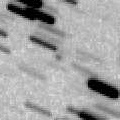
|
Now it is 17.8 mag (Jan. 2, Ken-ichi Kadota). It is expected to brighten up to 13.5 mag from June to July. It is observable only in the Southern Hemisphere at the high light. In the Northern Hemisphere, it is observable only until March when it brightens up to 16.5 mag.
Date(TT) R.A. (2000) Decl. Delta r Elong. m1 Best Time(A, h)
Jan. 8 1 13.47 14 7.0 2.182 2.469 94 17.6 18:34 ( 21, 68)
Jan. 15 1 10.40 11 32.0 2.247 2.391 86 17.5 18:40 ( 37, 62)
|

|
It brightened up to 11.6 mag in last winter (Feb. 18, Thomas Lehmann). Now it is fading. It has already faded down to 16.6 mag (Nov. 23, Thomas Lehmann). In the Southern Hemisphere, it stays observable in good condition after this. In the Northern Hemisphere, it will never be observable after this.
Date(TT) R.A. (2000) Decl. Delta r Elong. m1 Best Time(A, h)
Jan. 8 1 5.11 -54 30.9 5.095 4.857 70 17.7 18:34 ( 6, 0)
Jan. 15 1 5.78 -52 48.2 5.214 4.919 67 17.8 18:40 ( 11, 1)
|

|
It was observed at 16 mag from 2020 to 2021. Now it is fading. It will be fainter than 18 mag in spring.
Date(TT) R.A. (2000) Decl. Delta r Elong. m1 Best Time(A, h)
Jan. 8 15 41.35 -33 48.0 6.336 5.726 48 17.7 5:38 (324, 10)
Jan. 15 15 42.12 -34 31.7 6.270 5.757 54 17.7 5:38 (330, 12)
|

|
Peculiar asteroid moving along a cometary orbit. It is observable at 17.5 mag in good condition in January.
Date(TT) R.A. (2000) Decl. Delta r Elong. m1 Best Time(A, h)
Jan. 8 6 33.36 0 46.9 1.023 1.963 156 17.7 23:18 ( 0, 56)
Jan. 15 5 49.90 5 41.0 1.023 1.928 147 17.8 22:07 ( 0, 61)
|

|
It brightened very rapidly up to 10.7 mag in July (July 20, Osamu Miyazaki). Now it is fading. It has already faded down to 18.1 mag (Jan. 1, Toshihiko Ikemura, Hirohisa Sato).
Date(TT) R.A. (2000) Decl. Delta r Elong. m1 Best Time(A, h)
Jan. 8 8 22.65 30 53.2 1.431 2.388 162 17.8 1:15 ( 0, 86)
Jan. 15 8 11.79 31 17.4 1.477 2.449 168 17.9 0:37 ( 0, 86)
|
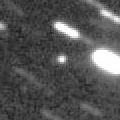
|
Now it is 17.2 mag (Jan. 7, Toshihiko Ikemura, Hirohisa Sato). In the Northern Hemisphere, it stays observable in good condition after this while the comet will be fading. In the Southern Hemisphere, it stays locating extremely low for a long time.
Date(TT) R.A. (2000) Decl. Delta r Elong. m1 Best Time(A, h)
Jan. 8 4 14.14 40 5.7 2.732 3.524 137 17.8 21:03 (180, 85)
Jan. 15 4 12.06 39 27.7 2.852 3.578 131 18.0 20:33 (180, 86)
|
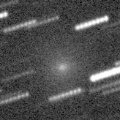
|
It brightened up to 12.7 mag in autumn (Oct. 9, Thomas Lehmann). It stays observable in good condition for a long time. But it is fading rapidly, and it will be fainter than 18 mag in January.
Date(TT) R.A. (2000) Decl. Delta r Elong. m1 Best Time(A, h)
Jan. 8 11 18.63 -12 27.0 1.336 1.922 111 17.8 4:10 ( 0, 42)
Jan. 15 11 17.64 -13 7.5 1.315 1.975 117 18.0 3:41 ( 0, 42)
|
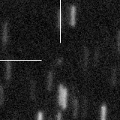
|
Now it is 17.5 mag (Jan. 1, H. Nohara). It is expected to brighten up to 12 mag from winter to summer in 2023. In the Northern Hemisphere, it stays observable in good condition until 2023 spring. In the Southern Hemisphere, it is not observable until summer.
Date(TT) R.A. (2000) Decl. Delta r Elong. m1 Best Time(A, h)
Jan. 8 1 22.76 53 45.0 5.019 5.418 108 17.8 18:34 (170, 71)
Jan. 15 1 24.45 52 25.6 5.043 5.360 103 17.8 18:40 (156, 70)
|
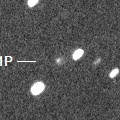
|
Now it is 17.6 mag (Jan. 3, Toshihiko Ikemura, Hirohisa Sato). It will be fainter than 18 mag in January.
Date(TT) R.A. (2000) Decl. Delta r Elong. m1 Best Time(A, h)
Jan. 8 9 1.20 18 48.3 1.537 2.464 155 17.8 1:53 ( 0, 74)
Jan. 15 8 53.69 18 8.8 1.543 2.502 163 17.9 1:18 ( 0, 73)
|

|
In the Northern Hemisphere, it stays observable at 17 mag in good condition from November to December. It locates low in the Southern Hemisphere.
Date(TT) R.A. (2000) Decl. Delta r Elong. m1 Best Time(A, h)
Jan. 8 1 46.57 24 0.8 1.456 1.964 105 17.8 18:35 ( 0, 79)
Jan. 15 1 44.75 22 33.9 1.514 1.914 97 17.9 18:40 ( 33, 76)
|
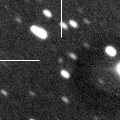
|
Now it is 17.4 mag (Jan. 2, J. Drummond). It will brighten up to 14 mag from 2024 to 2025.
Date(TT) R.A. (2000) Decl. Delta r Elong. m1 Best Time(A, h)
Jan. 8 7 27.59 -31 52.9 8.029 8.641 125 17.9 0:19 ( 0, 23)
Jan. 15 7 24.89 -31 56.1 7.980 8.603 126 17.9 23:45 ( 0, 23)
|
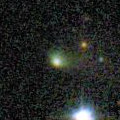
|
Now it is 17.5 mag (Jan. 3, Toshihiko Ikemura, Hirohisa Sato). It continued brightening even after the perihelion passage. But it will be fading after this, and it will be fainter than 18 mag in January.
Date(TT) R.A. (2000) Decl. Delta r Elong. m1 Best Time(A, h)
Jan. 8 1 15.17 -9 5.8 3.332 3.416 86 17.9 18:34 ( 10, 46)
Jan. 15 1 20.65 -8 9.9 3.468 3.458 81 18.1 18:40 ( 20, 45)
|
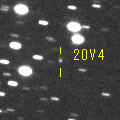
|
Now it is 17.5 mag (Jan. 3, Toshihiko Ikemura, Hirohisa Sato). It is observable at 18 mag in good condition in winter.
Date(TT) R.A. (2000) Decl. Delta r Elong. m1 Best Time(A, h)
Jan. 8 7 56.92 3 1.9 4.297 5.223 158 17.9 0:49 ( 0, 58)
Jan. 15 7 53.85 3 8.3 4.286 5.230 161 17.9 0:18 ( 0, 58)
|

|
It has not been observed yet in this apparition. It will be observable at 16 mag in good condition in spring.
Date(TT) R.A. (2000) Decl. Delta r Elong. m1 Best Time(A, h)
Jan. 8 14 23.51 -29 12.6 1.832 1.674 65 18.2 5:38 (338, 22)
Jan. 15 14 46.02 -30 45.6 1.752 1.638 66 17.9 5:38 (339, 21)
|
|
![]()
 C/2020 F7 ( Lemmon )
C/2020 F7 ( Lemmon ) 254P/McNaught
254P/McNaught 108P/Ciffreo
108P/Ciffreo C/2019 O3 ( Palomar )
C/2019 O3 ( Palomar ) 52P/Harrington-Abell
52P/Harrington-Abell 430P/2021 Q2 ( Scotti )
430P/2021 Q2 ( Scotti ) 230P/LINEAR
230P/LINEAR C/2020 S4 ( PanSTARRS )
C/2020 S4 ( PanSTARRS ) 274P/Tombaugh-Tenagra
274P/Tombaugh-Tenagra C/2019 T2 ( Lemmon )
C/2019 T2 ( Lemmon ) C/2022 A1 ( Sarneczky )
C/2022 A1 ( Sarneczky ) 10P/Tempel 2
10P/Tempel 2 C/2019 T3 ( ATLAS )
C/2019 T3 ( ATLAS ) 284P/McNaught
284P/McNaught 193P/LINEAR-NEAT
193P/LINEAR-NEAT C/2020 F2 ( ATLAS )
C/2020 F2 ( ATLAS ) 81P/Wild 2
81P/Wild 2 C/2020 U4 ( PanSTARRS )
C/2020 U4 ( PanSTARRS ) 119P/Parker-Hartley
119P/Parker-Hartley C/2021 D2 ( ZTF )
C/2021 D2 ( ZTF ) C/2021 U5 ( Catalina )
C/2021 U5 ( Catalina ) P/2021 W2 ( Kobayashi )
P/2021 W2 ( Kobayashi ) C/2018 N2 ( ASASSN )
C/2018 N2 ( ASASSN ) 99P/Kowal 1
99P/Kowal 1 C/2021 T2 ( Fuls )
C/2021 T2 ( Fuls ) C/2019 N1 ( ATLAS )
C/2019 N1 ( ATLAS ) C/2017 Y2 ( PanSTARRS )
C/2017 Y2 ( PanSTARRS ) 2021 WT6
2021 WT6 15P/Finlay
15P/Finlay 28P/Neujmin 1
28P/Neujmin 1 P/2021 Q5 ( ATLAS )
P/2021 Q5 ( ATLAS ) C/2021 Y1 ( ATLAS )
C/2021 Y1 ( ATLAS ) 241P/LINEAR
241P/LINEAR (3200) Phaethon
(3200) Phaethon C/2021 G2 ( ATLAS )
C/2021 G2 ( ATLAS ) C/2021 K1 ( ATLAS )
C/2021 K1 ( ATLAS ) P/2020 V4 ( Rankin )
P/2020 V4 ( Rankin ) 325P/Yang-Gao
325P/Yang-Gao![]()









































































